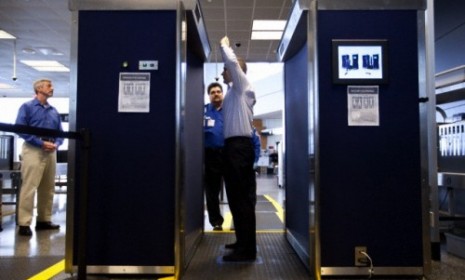Invasion of the body scanners
Are the security devices being installed at U.S. airports worth the cost?

What do the scanners do?
They see you naked—sort of. By mapping the human body and projecting an image of it onto a screen, body scanners allow security personnel to see beneath passengers’ clothing and view the contours of their bodies, along with anything that might be concealed. Scanners were introduced in the U.S. in 2007, but they became an important component of the Transportation Security Administration’s arsenal after a Nigerian man attempted to blow up a Detroit-bound airplane last Christmas using plastic explosives he’d smuggled aboard in his underwear. A few dozen scanners are in place today at 22 U.S. airports, but by the end of the year the TSA expects nearly 500 scanners to be operational. There are 730 checkpoints with 2,100 security lanes at America’s 450 airports. So for now, at least, scanning will be a secondary procedure at many airports, used mainly on passengers targeted for heightened scrutiny.
How do scanners work?
The Week
Escape your echo chamber. Get the facts behind the news, plus analysis from multiple perspectives.

Sign up for The Week's Free Newsletters
From our morning news briefing to a weekly Good News Newsletter, get the best of The Week delivered directly to your inbox.
From our morning news briefing to a weekly Good News Newsletter, get the best of The Week delivered directly to your inbox.
One type, called the millimeter wave scanner, bombards the body with radio waves. The traveler enters something akin to a phone booth, where he is hit with waves that travel through clothing but bounce off high-density materials, like metal. The reflected waves are then processed by a computer, which generates an image similar to a photo negative. The second kind, the backscatter scanner, uses high-energy rays that scatter when they hit objects, distinguishing, for example, between the density of a plastic gun and that of a human thigh. Images produced by backscatter scanners appear somewhat spectral and a little lumpy.
Are they dangerous?
The TSA assures us that they are not. A single backscatter scan exposes a person to minimal radiation—about the same amount you’d experience flying at 30,000 feet for two minutes. The energy projected by a scan using millimeter wave technology is 10,000 times less than that produced by a cell phone transmission. The American College of Radiology says travelers would need to undergo 2,500 scans to increase their risk of cancer even minimally. Both technologies meet national health and safety standards.
Do they invade our privacy?
A free daily email with the biggest news stories of the day – and the best features from TheWeek.com
It depends on your definition of “privacy.” TSA procedures require two security officers to supervise body scans. One is positioned next to the scanning machine, as the traveler steps inside, and is prohibited from seeing the computer image produced. The other—usually positioned dozens of yards away—views the image on the computer, but never sees the actual person being scanned. Travelers who object to being scanned can choose an alternative—a pat down by security officers that includes breast and groin areas. (In a recent Gallup poll, 70 percent of Americans said they would prefer a body scan to a pat down.) The TSA insists that images from the machines will not be stored or transmitted—but the machines do have the capacity to do both, and privacy advocates say abuses are inevitable. Just recently, a male employee at London’s Heathrow Airport reportedly scanned an unwitting female colleague and then commented on her breasts, prompting an investigation.
Will scanners actually improve security?
Certainly to some extent. Security analysts view scanners as just one part of a multilayered defense that includes metal detectors and human intelligence. “Will the body scanner add to the security? Yes,” says security expert Brian Jenkins. “Will it solve the problem and prevent all future terrorist attacks? No.” Still, some critics have raised doubts about the machines’ basic effectiveness. British Member of Parliament Ben Wallace, who worked for a firm that produces body scanners, says the machines can miss low-density objects like powders, and might not have caught the underwear bomber, who was carrying the explosive powder PETN. Nor are the machines likely to reveal explosives hidden in body cavities—which was the modus operandi of an al Qaida bomber in Saudi Arabia last year who hid a pound of high explosives in his rectum. “The device does not locate well-concealed items in body parts and cavities,” says Michael German of the American Civil Liberties Union. “It’s asking a lot of people to sacrifice their privacy for technology that’s not effective.”
How will scanners affect air travel?
They’ll slow it down. The average scan requires around 15 seconds per passenger but can take up to 40 seconds for some, while metal detectors require a fraction of that. With about 2 million people flying in the U.S. each day, scanners will produce “significant passenger delays,” says Steve Lott of the International Air Transport Association. And then there’s the cost factor. Though the exact amount is a matter of debate, current security measures cost the economy billions in lost productivity, in addition to the cost of technology and personnel. The scanners cost $130,000 to $200,000 apiece. But so far, Americans have been willing to do and spend almost anything to keep terrorists at bay. “I think that travelers welcome the additional security measures,” says Alan Dreher, AirTran Airways’ security chief. For a feeling of security, he says, “the flying public will be willing to put up with a little wait time.”
One step behind
In December 2001, Richard Reid attempted to blow up a U.S.-bound plane by igniting a bomb in his shoe. Ever since, airborne Americans have been removing their shoes. After terrorists used a peroxide-based explosive to bomb the London subway in 2005, airport security began confiscating liquids—from soda to shampoo. The underwear bomber represented the latest advance in terrorist tactics, and ushered in the latest reaction: full-body scanners. Unfortunately, no one believes that the most recent bombing attempt marks the end of what airline pilot and writer Patrick Smith calls “this unwinnable arms race/shell game,” in which we are always one step behind the terrorists’ latest adaptation. “We’re never going to make our airports and airplanes completely safe by means of banning, confiscating, and X-raying,” says Smith. “There will always be a way to skirt the system.”
-
 How the Bondi massacre unfolded
How the Bondi massacre unfoldedIn Depth Deadly terrorist attack during Hanukkah celebration in Sydney prompts review of Australia’s gun control laws and reckoning over global rise in antisemitism
-
 Received a gift card this holiday season? Here’s how to maximize it.
Received a gift card this holiday season? Here’s how to maximize it.The Explainer Make the most of your present
-
 ‘Lumpy skin’ protests intensify across France as farmers fight cull
‘Lumpy skin’ protests intensify across France as farmers fight cullIN THE SPOTLIGHT A bovine outbreak coupled with ongoing governmental frustrations is causing major problems for French civil society